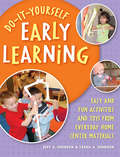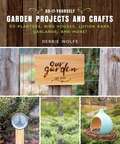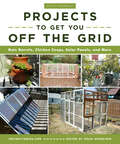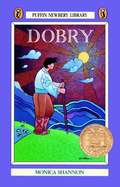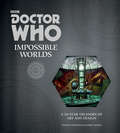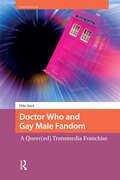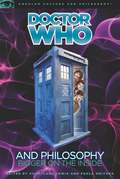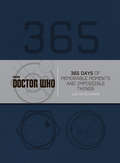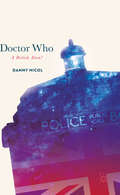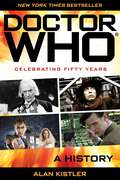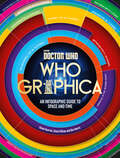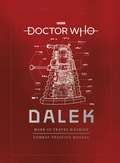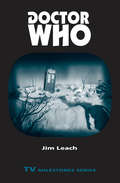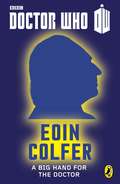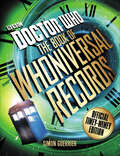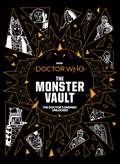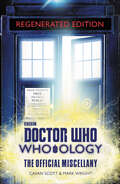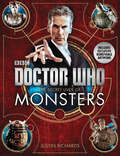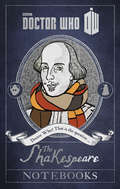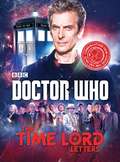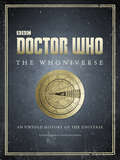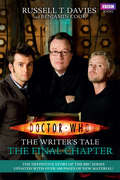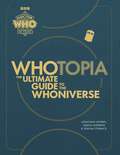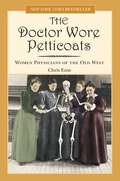- Table View
- List View
Do-It-Yourself Early Learning
by Jeff A. Johnson Tasha A. JohnsonMaking learning a hands-on experience, Do-It-Yourself Early Learning shows home child care providers how to find and use many of the inexpensive--and often overlooked--building, home-repair, and construction materials available at local hardware stores and home centers to create fun activities and toys that promote play, exploration, and discovery.This innovative guide takes teachers on a journey through the aisles of the local home center to help them find creative ways to teach young children to build, interact, and learn from a wide variety of materials--from plumbing and electrical supplies to paints and hardware items.
Do-It-Yourself Garden Projects and Crafts: 60 Planters, Bird Houses, Lotion Bars, Garlands, and More
by Debbie WolfeImprove Your Garden and Home with Easy DIY Projects and Beautiful Botanical Crafts Create your dream garden with simple bird baths, herb drying racks, and unique planters. And bring the outdoors indoors with natural fabric dyes, pressed flower paper, and herbal bouquets. <P><P>DIY Garden Projects and Crafts book relies on home grown and foraged materials that will inspire creativity and capture the bounty of the seasons. The sixty practical and decorative projects for use in the garden and home include: <br>Gardener's Tool Apron <br>Metal garden charms <br>Veggie Market Tote <br>Macrame produce bag <br>Gourd bird feeder <br>Kirigami leather hanging planter <br>Tomato cage plant stand <br>Shibori Dyed Fabric <br>Herbal lotion bars <br>Gardener hand scrub <br>All-purpose thyme cleaner <br>And more! <P><P>Do-It-Yourself Garden Projects and Crafts features detailed, step-by-step instructions as well as simple crafting and gardening tips that will make your projects successful.
Do-It-Yourself Projects to Get You Off the Grid: Rain Barrels, Chicken Coops, Solar Panels, and More
by Noah WeinsteinInstructables is back with this inspiring book focused on a series of projects designed to get you thinking creatively about going green. Twenty Instructables illustrate just how simple it can be to make your own backyard chicken coop, or turn a wine barrel into a rainwater collector. Here, you will learn to: • Clip a chicken’s wings • Power your lawn mower with solar power • Create a chicken tractor for the city • Water your garden with solar power • Build a thermoelectric lamp • Create an algae bioreactor from water bottles • And much more! Illustrated with dozens of full-color photographs per project accompanying easy-to-follow instructions, this Instructables collection utilizes the best that the online community has to offer, turning a far-reaching group of people into a mammoth database churning out ideas to make life better, easier, and, in this case, greener, as this volume exemplifies.
Dobry
by Monica ShannonThere is always something to look forward to in Dobry's small Bulgarian village. From the delicious peppers and tomatoes he helps his mother and grandfather grow, to the visiting Gypsy Bear, to the Snow-Melting games that are the highlight of winter, Dobry lives within the circle of the year--and uses it in the art he shares with his friend Neda.<P><P> A Newberry Medal winner.
Doctor Faustus: With The English Faust Book
by Christopher Marlowe David WoottonThis edition of Doctor Faustus features annotated versions, with modernized spelling and punctuation, of the 1604 A-text and the 1592 text of Marlowe's source, the English Faust Book--a translation of the best-selling Historia von Johann Fausten published in Frankfurt in 1587, which recounts the strange story of Doctor John Faustus and his pact with the spirit Mephistopheles.David Wootton's Introduction charts Marlowe's brief, meteoric career; the delicate social and political climate in which Doctor Faustus was staged and the vexed question of the religious sensibilities to which it may have catered; the interpretive significance of variations between the A and B texts; and the shrewd and subversive uses to which Marlowe put the English Faust Book in crafting, according to Wootton, a drama in which orthodox Christian teaching triumphed, but in which Faustus has all the best lines.
Doctor Who Impossible Worlds: A 50-Year Treasury of Art and Design
by Mike Tucker Stephen NicholasAn intimate, behind-the-curtains tour of the sets, costumes, spacecraft, alien planets, creatures, weapons, and gadgets used to create the stunning world of Doctor Who. From distant galaxies in the far-flung future, to ancient history on the planet Earth, Doctor Who is unique for the breadth of imaginative possibilities it offers the artists charged with bringing each episode to life. Mining the depths of the BBC archives, Stephen Nicholas and Mike Tucker have compiled this breathtaking collection of rare and never-before-published images that are interwoven with fascinating insights from the show's writers. Showcasing the work of Doctor Who's remarkable designers, Doctor Who: Impossible Worlds pays tribute to the care and attention to detail essential to creating the look of the show, from the characters themselves-including recurring villains like the Daleks or the Cybermen-to the smallest hand prop featured in the briefest of scenes, to the TARDIS console room and other regularly used sets. Doctor Who: Impossible Worlds explores how the art department works together with costumers and make-up and special effects artists to produce a coherent look for a diverse range of alien worlds; reveals how the artists' relationship with the computer graphics department allows them to create locations far grander than possible in the real world; and shows how today's creative artists have built upon the designs produced by their predecessors-the pioneers of the program's "classic" era whose legacy has delighted audiences since 1963. Divided thematically, Doctor Who: Impossible Worlds examines the history of the program and its art and set design, and highlights how various re-occurring designs have evolved over time. Chock full of surprising, illuminating, and fascinating information, photographs, and trivia, Doctor Who: Impossible Worlds is essential for every Whovian, whether you're an established fan or are new to the show.
Doctor Who and Gay Male Fandom: A Queer(ed) Transmedia Franchise (Transmedia)
by Mike StackDoctor Who is a BBC transmedia franchise that has lasted over sixty years. Its fanbase boasts a substantial following of gay men. This book asks why this should be. Through examining four core components, the Doctor, the TARDIS, the companion and the Daleks, this book traces the trajectory of queerness from wider culture to paratextual media and finally into the parent text, resulting in an inclusive brand. In doing so, it argues that fandom provides a space to mediate between personal identities and the wider world. Drawing from interviews with fans, the book demonstrates the complexities and contradictions of queerness, and proposes an alternative theory of gay cultural formation. This is the first book-length study to use queer theory to understand Doctor Who. It will be of interest to students and teachers of media theory and fan studies, psychosocial studies, queer theory and history, as well as Doctor Who fans. • First book-length queer theory analysis of Doctor Who • Contributes to fan studies debates on non-productivist fandom • Draws upon case studies of real-life fans, as well as quantitative data.
Doctor Who and Philosophy (Bigger on the Inside)
by Courtland Lewis Paula SmithkaIn Doctor Who and Philosophy, a team of mostly human philosophers (who are also fans) looks at the deeper issues raised by the Doctor's mind-blowing adventures. They discuss, among other topics, the Doctor's philosophy of science, the ethics of a universe with millions of intelligent species, what makes one life-form more important than another, whether time travelers can change history, and how the Doctor Who TV show is changing the world we live in. The chapters draw freely on both the classic series (1963-1989) and the new series. The book includes a collection of entertaining and insightful quotes from Doctor Who plus a complete list of episodes and companions.
Doctor Who: 365 Days of Memorable Moments and Impossible Things
by Justin Richards23 November 1963: The first-ever episode of Doctor Who--"An Unearthly Child"--is broadcast.21 July 1969: Silence will fall.23 August 2014: "Deep Breath" is Peter Capaldi's first full episode as the Twelfth Doctor.3 March 2472 The Master tracks down the Doomsday Weapon. For over half a century, Doctor Who has entertained and enthralled fans with the adventures of the Doctor. From the first glimpse of a police telephone box in a junkyard to the fall of Gallifrey, Doctor Who has provided a near-inexhaustible list of indelible memories.Doctor Who: 365 Days is a unique and captivating chronicle of drama or humor, terror or joy, for each and every day of the year. Revisiting classic battles, iconic characters, game-changing plot twists, and more, it's a fascinating portrait of the Whoniverse and an essential addition to any fan's collection.
Doctor Who: A British Alien?
by Danny NicolThis book argues that Doctor Who, the world's longest-running science fiction series often considered to be about distant planets and monsters, is in reality just as much about Britain and Britishness. Danny Nicol explores how the show, through science fiction allegory and metaphor, constructs national identity in an era in which identities are precarious, ambivalent, transient and elusive. It argues that Doctor Who's projection of Britishness is not merely descriptive but normative--putting forward a vision of what the British ought to be. The book interrogates the substance of Doctor Who's Britishness in terms of individualism, entrepreneurship, public service, class, gender, race and sexuality. It analyses the show's response to the pressures on British identity wrought by devolution and separatist currents in Scotland and Wales, globalisation, foreign policy adventures and the unrelenting rise of the transnational corporation.
Doctor Who: A History
by Alan KistlerPremiering the day after the JFK assassination, Doctor Who humbly launched one of the entertainment world’s first super-brands. We begin with a look at TV programming of the day and the original pitch documents before delving into the Daleks, which almost didn’t make the cut but inspired many monsters to follow. After three years, First Doctor William Hartnell left, prompting the BBC to recast their hit rather than end it, giving us the first “regeneration” and making TV history. We follow the succession of Doctors—including Third Doctor Jon Pertwee, exiled to Earth and targeted by the Master—and see how the program reflected the feminism of the 1970s while gaining mainstream popularity with Fourth Doctor Tom Baker . . . until declining support from the BBC eventually led to cancelation. Fan outcry saved the series only for it to suffer a repeat cancelation. Yet many continued to enjoy the Whoniverse in syndication, novels, audio dramas, and Doctor Who Magazine. Paul McGann impressed many as the Eighth Doctor in a 1996 TV movie, but it failed to reignite the series. A new age dawned in 2005 with Ninth Doctor Christopher Eccleston and a serious special effects budget before Tenth Doctor David Tennant helped rocket the series to international popularity and a new era of spinoffs. With Eleventh Doctor Matt Smith, the show became a bona fide success here in America. Following the program’s fiftieth anniversary, Whovians will meet the Twelfth Doctor, ushering in yet another era for the unstoppable Time Lord.Featuring discussions of concepts and characters, with insights from producers, writers, and actors from across the years, here is a rich, behind-the-camera investigation into the dazzling multiverse of Doctor Who.
Doctor Who: An Infographic Guide to Space and Time
by Simon Guerrier Ben Morris Steve O'BrienExplore the rich history of Doctor Who like never before, through colorful and creative visualizations and infographics in this captivating, intriguing, beautiful, and strange compendium.The Doctor’s family tree, the strangest weapons in the whole universe, the frequency of the letter "A" in the names of companions—these curiosities, and many others, are explored in detail, complete with visually-stunning infographics in Doctor Who: Whographica. Each double-page spread presents a fascinating, visual insight into a particular aspect of Doctor Who. Divided into twelve sections—The Doctor, Earth, Daleks, the TARDIS, Friends and Companions, Alien Worlds and more—Whographica features double-page spreads which offer fascinating, visual insight into a particular aspect of the show.With interesting and fascinating information, Whographica is a perfect introduction to the extraordinary universe of the series, and an engaging sourcebook that will delight long-term aficionados, presenting the history of Doctor Who in an entirely new and enthralling way.
Doctor Who: Dalek Combat Training Manual
by Mike Tucker Richard Atkinson Gavin RymillKnow your enemy.The Daleks are the most evil creatures ever created - genetically engineered mutants encased in a machine that is optimised to kill. They hate all other life forms and will stop at nothing to destroy those who stand in their way - their single-minded imperative? To become the dominant species in the universe.The Dalek Combat Training Manual collates intelligence gathered by Time Lords over centuries of raging wars through time and space, and is invaluable to anyone engaging the Daleks in battle. It furnishes the user with an in-depth guide to their construction, their strategies and how they are to be ultimately defeated. Discover full schematics of Dalek spacecraft, insights into the Dalek factions, a history of the Time War, detailed analysis of their creator Davros, and much more.This manual is the definitive guide to one of the most feared races in the Whoniverse.
Doctor Who: Doctor Who
by Jim LeachA comprehensive account of Doctor Who as a television series and product of popular culture.
Doctor Who: First Doctor (Doctor Who: 50th Anniversary Short Stories #1)
by Eoin ColferEleven Doctors, eleven months, eleven stories: a year-long celebration of Doctor Who! The most exciting names in children's fiction each create their own unique adventure about the time-travelling Time Lord.London, 1900. The First Doctor is missing both his hand and his granddaughter, Susan. Faced with the search for Susan, a strange beam of soporific light, and a host of marauding Soul Pirates intent on harvesting human limbs, the Doctor is promised a dangerous journey into a land he may never forget...
Doctor Who: Official Timey-wimey Edition
by Simon GuerrierA fact-packed, full-color illustrated collection of records that celebrates the best, biggest and most memorable moments from the world of Doctor Who.Doctor Who: The Book of Whoniversal Records is a handy compilation of the greatest—and strangest—details from the brilliant, imaginative world of Doctor Who. Bursting with firsts and bests both human and alien, this expansive compendium has the answer to any and every question about the Doctor, his companions and adversaries, and his adventures through time and space.Discover a multi-universe of astounding facts, figures, and fun—from the biggest explosion in the universe to the first human to time-travel; from the longest fall through space to the shortest life-form that ever lived—inside this ultimate must-have reference. Filled with full-color images throughout, Doctor Who: The Book of Whoniversal Records is a must for every Doctor Who devotee everywhere . . . and everywhen.A Whovian twist on bestselling gift reference books such as The Guinness Book of World Records, Ripley’s Believe It Or Not, and Star Wars: Absolutely Everything You Need to Know, this informative and entertaining digest features a cool graphic cover with special effects that reflects the Doctor Who aesthetic.
Doctor Who: The Monster Vault
by Jonathan Morris Penny CS AndrewsYou're going to need a bigger sofa...Doctor Who's biggest and most comprehensive monster guide yet, The Monster Vault takes you on the ultimate tour of the Whoniverse, discovering and cataloguing every wonderful and terrifying creature the Doctor has ever encountered.From the notorious Daleks, to evil Stenza warrior Tzim-Sha and the ancient Thijarians, The Monster Vault features in-depth profiles on each monster, showing the Doctor's most dangerous enemies in their natural habitat and unveiling their secret histories. You will also discover how monsters were created and designed, behind-the-scenes secrets, unseen details from the original scripts, case studies and rare artwork.This lavish and visually stunning book provides an unrivalled wealth of information, allowing you to explore the rich history of Doctor Who and expand your knowledge and understanding of characters old and new.
Doctor Who: The Official Miscellany
by Cavan Scott Mark WrightHow many planets has the TARDIS visited? Can you name the Doctor’s favorite Gallifreyan bedtime stories? What’s the best way to defeat a Sontaran?Put your Time Lord knowledge to the test with an extraordinary journey through fifty-five years of Doctor Who.Now fully updated to take in the Twelfth Doctor’s final episode, this unique tour of space and time is packed with facts, figures, and stories from the show’s entire run. Peek inside the inner workings of the TARDIS, trace the Doctor’s family tree, and learn how to defeat his most fearsome enemies.I imagine you have many questions. Fire away.I might answer some of them…
Doctor Who: The Secret Lives of Monsters Apple FF
by Justin RichardsA unique, in-depth look into the hidden lives and mysteries of the monsters from the hit BBC series Doctor Who—a fully illustrated color compendium that reveals proof of the existence of alien life out there and among us, packaged with removable artwork commissioned exclusively for the book.For years, world governments and multinational organizations like the secretive UNIT have suppressed the truth. In this book, leading alientologist Justin Richards finally blows the lid off the biggest conspiracy to radically alter our world since The Scarlioni Incident.Not only is there proof that alien life exists. The aliens are already here. Based on exclusive access to classified UNIT and Torchwood files—shocking information that has been suppressed for centuries—The Secret Lives of Monsters reveals the terrifying truth behind the rumors and legends.Packed with iconic photographs, eyewitness accounts, diagrams and illustrations, and sixteen removable color prints, The Secret Lives of Monsters offers background details on a diverse range of alien species—including planetary and genetic origins, habits, social organization, and first human contact. If you want to know why the Sontaran’s probic vent is his weak point or what it is used for; how Daleks reproduce; or how to determine whether your best friend is a Zygon, the answers—as well as everything you need to know to survive future invasions—are here in The Secret Lives of Monsters.
Doctor Who: The Shakespeare Notebooks
by Justin RichardsMany people know about William Shakespeare's famous encounter with the Doctor at the Globe Theatre in 1599. But what few people know (though many have suspected) is that it was not the first time they met.Drawn from recently discovered archives, The Shakespeare Notebooks is the holy grail for Bard scholars: conclusive proof that the Doctor not only appeared throughout Shakespeare's life but also had a significant impact on his writing. In these pages you'll find early drafts of scenes and notes for characters that never appeared in the plays; discarded lines of dialogue and sonnets; never-before-seen journal entries; and much more.From the original notes for Hamlet (with a very different appearance by the ghost) and revealing early versions of the faeries of A Midsummer Night's Dream to strange stage directions revised to remove references to a mysterious blue box, The Shakespeare Notebooks is an astonishing document that offers a unique insight into the mind of one of history's most respected and admired figures. And also, of course, William Shakespeare.
Doctor Who: The Time Lord Letters
by Justin RichardsA unique collection of more than 100 never-before-seen letters, notes, and jottings both by and to the Doctor—correspondence by turns entertaining and inspiring, funny and flippant, brilliant and incredible drawn from all fifty-two years of the show.No one could travel through history—past present and future—as much as the Doctor does without leaving an impression. Much of what we know about this mysterious figure comes from what he does— the planets he saves and the monsters he defeats. But until now we’ve had little knowledge of his writings.These rich and diverse documents paint an extraordinarily detailed picture of the Doctor and include his plea to the Time Lords to help end the War Games, an extract from the written defense he submitted at his subsequent trial, his application for the post of Caretaker at Coal Hill School, his apology to the Queen for missing dinner, even telepathic messages to the High Council on Gallifrey and his famous letter to Santa Claus. Like the Doctor himself, the mood can change in an instant.The Time Lord Letters captures the best and most dramatic moments of an impossible life. You’ll never see the Doctor in quite the same way again.
Doctor Who: The Untold History of Space and Time
by Justin Richards George MannComplete with full-color illustrations, maps, charts, and artifacts, the definitive, essential companion to the Doctor's world--and many more.Doctor Who: The Whoniverse is a never-before-seen history of the Human Race--from the formation of the Earth around the Racnoss eggs, and the creation of life by the destruction of the last Jagaroth spaceship, through to the eventual expansion of the sun and end of the world and beyond to the New Earth, and Utopia.Along the way, the book explores the untold histories of other planets and other lifeforms as they have interacted with humanity. We examine the Daleks and Cybermen, the Time Lords and the Sontarans, the Ice Warriors, Silurians, Weeping Angels, and many, many more. Additionally, we visit Gallifrey and Skaro, Mondas and Telos, Mars and Sontar. Filled with full-color illustrations, maps, charts, and artifacts throughout, Doctor Who: The Whoniverse is a treasury of accumulated knowledge, scholarly erudition and accumulated folk wisdom from the worlds of Doctor Who.Doctor Who: The Whoniverse explores:Early History--From 10,000 BC and the discovery of the secret of fire, through the Roman Empire;Gallifrey--The rise of the Time Lords;The UNIT Era--Earth under attack from alien invasions;The Cyberwars--The Wheel in Space and Revenge of the Cybermen;Earth's Galactic Empire--Starting in present day through the rise of Earth's Empire as seen in Frontier in Space;And much more!
Doctor Who: The Writer's Tale: The Final Chapter (DOCTOR WHO #78)
by Benjamin Cook Russell T DaviesFor this new edition of The Writer's Tale, Russell T Davies and Benjamin Cook expand their in-depth discussion of the creative life of Doctor Who to cover Russell's final year as Head Writer and Executive Producer of the show, as well as his work behind the increasingly successful Torchwood and The Sarah Jane Adventures spin-offs. Candid and witty insights abound throughout two years' worth of correspondence, covering David Tennant's last episodes as the Doctor and the legacy that Russell and David leave behind as a new era of Doctor Who begins.With over 300 pages of new material, and taking in events from the entire five years since the show's return in 2005, The Writer's Tale: The Final Chapter is the most comprehensive - and personal - account of Doctor Who ever published.
Doctor Who: Whotopia
by Jonathan Morris Simon Guerrier Una McCormackWelcome to the Whoniverse. First stop: everywhere.Six decades may only be a handful of heartbeats to a Time Lord, but for Doctor Who it's the adventure of several lifetimes. Evolving over 60 years, the world's longest-running sci-fi TV show has gifted us a universe of menacing monsters and unforgettable heroes. You might even call it a 'Whotopia'.Now you can roam free through the Doctor's dimension as never before in this special commemorative book for Doctor Who's diamond anniversary. Join all the Doctors as each tells their own story. Learn about their legions of legendary allies - and hear from the monsters' own mouths about what makes them tick. Find danger on alien worlds and threats here on Earth in all eras. And explore the gadgets, robots, spaceships, computers and mind-blowing creations that crowd the never-ending corridors of Whotopia.Crammed with exciting new images and in full colour throughout, Whotopia: The Ultimate Guide to the Whoniverse is the essential celebration of 60 years of Doctor Who.
Doctor Wore Petticoats: Women Physicians of the Old West
by Chris Enss"No women need apply." Western towns looking for a local doctor during the frontier era often concluded their advertisements in just that manner. Yet apply they did. And in small towns all over the west, highly trained women from medical colleges in the East took on the post of local doctor to great acclaim. These women changed the lives of the patients they came in contact with, as well as their own lives, and helped write the history of the West. In this new book, author Chris Enss offers a glimpse into the fascinating lives of ten of these amazing women.
